History
![]() News
News ![]() Products
Products ![]() Pricing
Pricing ![]() Distribution
Distribution ![]() Notes & Interesting Articles
Notes & Interesting Articles
SBIG RESEARCH LINE:
Large Format, Dual Head Triple Sensor, Self-Guiding CCD Cameras
New Product Announcement March 2004
| The New Research Line: Dual Head Triple Sensor Self-guiding Internal Filter Wheel 1, 1.3, 4.2, 6.3, or 11 Megapixel CCD Cameras From _________ SBIG |
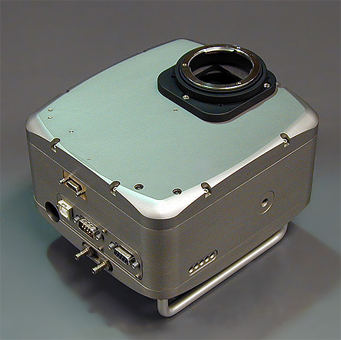 |
Click on image to see enlarged view.
Production begins in Fall 2003, deliveries starting February 2004*
*Company Seven does not often publish preliminary information about new products.However, since the credibility of the management and of the products at SBIG are so well regarded,
we believe it is worthwhile to make this interesting information available to our customers
ALL NEW DESIGN
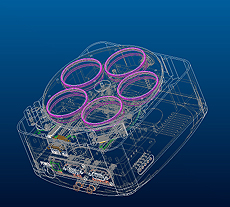 |
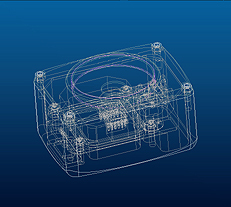 |
The Research Line
of cameras is an all new camera design that has been over two years in the making. The highly competent SBIG design team has combined the best features and ideas from past designs and updated the current camera high speed electronics and USB interface
to handle these new and larger format CCDs (up to 35mm
format with 11 megapixels). New features include a dual head self-guiding
option, simplified power requirements and an internal 2" filter wheel for overall
system cost and weight reduction. These large format cameras are designed to provide
more features at a lower price than other previously available cameras. The design team goals included the production of a high performance imaging system that included large area detectors, flexible self-guiding options, a large format filter wheel, and all of this at a lower price than competing cameras alone. We at Company Seven concur, SBIG has achieved that goal. Click here to see pictures of the finished camera body and PDF format mechanical drawings.
DUAL HEAD, TRIPLE SENSOR, SELF-GUIDING
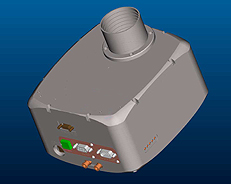 |
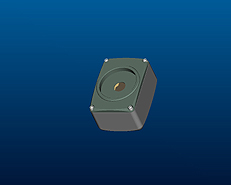 |
The best of both worlds. We have expanded the self-guiding capabilities in the Research cameras by adding the option of a remote guiding head. With the remote guiding head attached, there are two, software selectable, TC-237 CCDs available for self-guiding under any conditions in addition to the main imaging CCD. One guiding CCD is located next to the imaging CCD in our patented design, similar to the self-guiding arrangement in our ST line of cameras. The remote guiding CCD is in a small separate head that attaches to the main camera body by a short cable. There is no separate power supply or communication cable required. The remote head contains its own TE cooler and shutter. With the optional remote guiding head attached to the main camera body, self-guiding is accomplished by selecting either the internal TC-237 tracking CCD or the remote TC237 CCD using the camera control software. The benefits of this flexibility are obvious. Internal guiding eliminates the need for a guide scope and separate autoguider. It also eliminates the problem of differential deflection of the guide scope or differential motion of the primary mirror relative to the guide scope. However, some users prefer to use an external guider when imaging through dark infrared band or narrow band filters, or for RGB color imaging in regions of the sky with sparse guide stars. The remote guiding head may be used in an off-axis guiding accessory or attached to a separate guide scope. There is only one small cable between the remote head and the main camera body. The remote head can be left connected and the user may freely switch between the internal or the remote TC-237 for self-guiding. All the guiding functions are controlled by the same camera software that normally controls the internal guider. Click here to see a prototype camera and remote head attached to 5" refractor and 8" SCT.
INTERNAL 2" FILTER CAROUSEL
 |
An internal 5
position 2" filter carousel is integrated into the front cover of the camera
body. For color, UBVRI, or narrow band imaging simply add filters to the camera's
carousel. There is no expensive separate 2" filter wheel to purchase.
The filter carousel accepts both 50mm diameter flats and 48mm threaded filter cells.
The front cover of the camera is easily removed for changing filters. Since the CCD
is in a separate sealed chamber, removal of the front cover to change filters does not
expose the CCD to dust or air and the desiccant does not need to be recharged after
replacing the cover. Extra carousels may be purchased for quick and easy transition
between filter sets. A shutter mechanism is also located inside the camera body,
between the filter wheel and the sealed CCD chamber. A custom LRGBC filters set is optional.
12VDC OPERATION
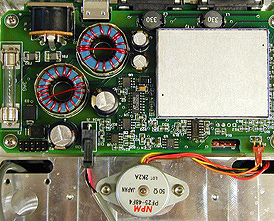 |
We have added an internal
12VDC regulated power supply to the camera for simplified power requirements and
greater tolerance of input voltage variation. When operating in the field from a
12V battery, current drain, power cord extensions and cold temperatures may cause the
input voltage to drop below 12 volts. The internal regulated supply will
accommodate some variation in input voltage (from about 10 volts to 18 volts) and keep the
camera operating normally. This will allow for longer power cords to be used
with less concern for voltage drops so long as the input voltage stays within a certain
range. A set of indicator LEDs will let you know if your input voltage at the camera
is getting too low for normal operation. A universal 110VAC-220VAC to 12VDC power
supply is also included for operation from virtually any line voltage in the world.
INTELLIGENT
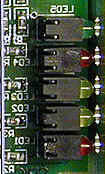 |
A set of five LED
indicator lights on the side panel of the camera provide critical camera status
information. The green LED lets you know the camera is booting up and gives camera
exposure status during normal operation. One red LED provides a warning if the heat
sink gets too hot. This could happen, for instance, if you were running high power
to the cooler and the fan failed for some reason. In this case the camera
automatically reduces power to the two-stage cooler to prevent damage. One amber LED
warns of an input voltage drop to 11 volts or less but the camera will continue
functioning normally. The second amber LED warns of an input voltage drop to 10
volts but the camera will still continue functioning normally. The last red LED
warns of an input voltage drop to 9 volts or less. In this case, the camera
automatically turns off the TE cooler and continues to operate normally without cooling
until the voltage drops to the point that the camera shuts down (around < 7 volts).
TWO STAGE COOLING WITH WATER ASSIST
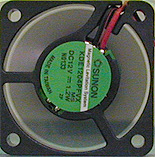 |
The standard cooling design utilizes a very efficient two-stage TE cooler for maximum performance with large format detectors. Each camera is also liquid assist ready so that additional cooling in warm climates may be achieved by circulating water if needed. We are currently testing a special magnetic levitating fan to eliminate even the smallest vibration. Preliminary tests indicate that cooling -50 Degrees C below ambient will be achieved with this system.
DELUXE ACCOMMODATIONS
Every Research Model camera will be shipped in a custom fitted Pelican brand carrying case for superior protection of your equipment. These cases are waterproof, dustproof, crushproof and have a lifetime guarantee from the manufacturer. Each Pelican case has an automatic pressure relief valve and double hinged latches for easier opening. There is ample room inside for the camera, cables, wall transformer and some accessories in the custom cut foam insert. An optional lid pocket is available from Pelican that will hold charts and manuals.
CAMERA MECHANICAL SPECIFICATIONS
| Mechanical Specifications Common to All Models (Typical) | |
| Dimensions | 6.5 x 6 x 3.5 inches (16.5 x 15.2 x 8.9 cm) excluding nosepiece and handles |
| Weight | Approx. 4 lbs. (1.8kg) without filters |
| Computer Interface | USB 1.1 (transfer rate approx. 425,000 pixels/second) |
| Telescope Interface | Threaded accessory ring, mounting plate and 2" nosepiece supplied, Nikon 35mm lens adapter optional |
| Filter Wheel | 5 position internal carousel accepts 48mm threaded filter cells and 2" unmounted round filters |
Shutter |
Internal Mechanical Shutter on all cameras, plus electronic shutter on Interline CCDs |
| Cooling | 2 stage thermoelectric, water circulation ready, - 50o C below ambient, regulated to +/- 0.1 degree |
| Backfocus | Approximately 1.7 inches +/- 0.1 inches (~4.3 cm +/- 0.25 cm) with 2" nosepiece attached |
| Power Requirements | 10
- 18VDC, 12VDC nominal, Universal AC to 12VDC desktop supply and 12VDC field power cord supplied |
| Carrying Case | Pelican 1550 Case with custom cut foam insert |
| Software | CCDOPS ver. 5.xx, CCDSoftV5, CCDSharp, TheSky v.4, level II. |
REMOTE HEAD MECHANICAL SPECIFICATIONS
| Mechanical Specifications Common to All Models (Typical) | |
| Dimensions | 2.75 x 2 x 2 inches (7 x 5 x 5 cm) excluding nosepiece and desiccant plug |
| Weight | Approx. 0.5 lbs. (0.23kg) |
| Computer Interface | USB 1.1 through main camera to computer. Proprietary protocol between remote head and camera body. |
| Telescope Interface | T-thread or supplied 1.25" nosepiece, optional T-thread to C-mount and 35mm camera lens adapters |
| Shutter | Internal Mechanical Shutter for dark frames plus electronic shutter for short exposures |
| Power Requirements | None (Remote head receives power through the head cable from the main camera) |
| Mounting connections | 1/4-20 threaded holes on two sides of head |
TYPICAL SPECIFICATIONS AND PRICE
| Model | Research STL-4020M/CM | Research STL-1301E | Research STL-1001E | Research STL-11000M/CM | Research STL-6303E | Internal Guiding CCD | Optional Remote Head |
| CCD | KAI-4020M/CM | KAF-1302E/LE | KAF-1001E | KAI-11000M/CM | KAF-6303E/LE | TC-237H | TC-237H |
| Total Pixels | 4 million | 1.3 million | 1 million | 11 million | 6.3 million | 325,000 | 325,000 |
| Array | 2048 x 2048 | 1280 x 1024 | 1024 x 1024 | 4008 x 2745 | 3072 x 2048 | 657 x 495 | 657 x 495 |
| Dimensions | 15 x 15 mm | 20.5 x 16.4 mm | 24.5 x 24.5 mm | 36 x 24.7 mm | 27.7 x 18.5 mm | 4.9 x 3.7 mm | 4.9 x 3.7 mm |
| Pixel Size | 7.4 x 7.4 u | 16 x 16 u | 24 x 24 u | 9 x 9 u | 9 x 9 u | 7.4 x 7.4 u | 7.4 x 7.4 u |
| CCD Type | Interline | Full Frame | Full Frame | Interline | Full Frame | Frame Transfer | Frame Transfer |
| CCD Class Available |
Class 2 (only) |
Class 2 (only) |
Class 1, 2, 3 | Mono Class 1 only Color Class 1, 2 |
Class 1, 2 | Single class with no column defects |
Single class with no column defects |
| ABG/NABG | ABG only | NABG standard ABG on request |
NABG only | ABG only | NABG standard ABG on request |
ABG only | ABG only |
| Full Well Capacity | 40,000 e- | 120,000 e- | 200,000 e- | 50,000 e- | 100,000 e- | 20,000 e- | 20,000 e- |
| Dark Current e-/p/s @ 0C | TBA | 5.6 e- | 34 e- | 1.5 e- | 1 e- | 25 e- | 25 e- |
| Read Noise rms |
16 e- | 16 e- | 16 e- | 11 e- | 15 e- | 15 e- | 15 e- |
| Full Frame Download | ~10 seconds | ~3 seconds | ~2.5 seconds | ~26 seconds | ~15 seconds | <1 second | <1 second |
| Price with Class 3 CCD |
N/A | N/A | $7995 | N/A | Included | $695 | |
| Price with Class 2 CCD |
$7495 (Mono or Color) |
$7795 | $10,995 | $7995 (Color Only) |
Included | $695 | |
| Price with Class 1 CCD |
N/A | N/A | $12,995 | $8995 (Mono or Color) |
$32,995 | Included | $695 |
Note: The Class 2 CCDs from Kodak mentioned above have no column defects with the exception of the color version of the KAI-11000CM class 2 which can have column defects. The Class 1 versions of all CCDs, color and mono, including the KAI-11000M and CM have no column defects. CCD specifications quoted above are considered typical based on a small sample. For minimum, nominal and maximum CCD specifications please refer to the Kodak web site for specifications of the particular CCD.
Option |
Price | |
|
Remote Guiding Head with TC237H CCD, |
$695 |
 |
Replacement 6' head cable for Remote Guiding Head |
$80 |
 |
50mm LRGBC Filter Set | $695 |
 |
Extra Filter Carousel |
$90 |
 |
12VDC Power Cable with Cigarette Lighter Adapter |
$70 |
 |
Nikon 35mm Lens Adapter | $195 |
 |
12VDC Water Pump Kit: Mounting plate, 12VDC Cord, Cigarette Lighter Adapter, 6' clear tubing, reducer, and fittings (110VAC power supply sold separately) | $129 |
 |
Relay Adapter Box |
$109 |
| N/A | 9' Extension Cable for Camera AC power supply | $35 |
| N/A | 110VAC Power Supply for Water Pump | $36 |
| N/A | 50mm UBVRI Five Filter Set | $1450 |
| N/A | 50mm BVR Three Filter Set | $870 |
| N/A | 50mm H-alpha Filter, 4.5nm, AR coated | $575 |
| N/A | 50mm H-alpha filter, 10nm, AR coated | $495 |
The Research STL-11000M
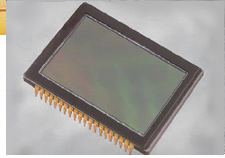 |
CCD:
KAI-11000M Total Pixels: 11 million Array: 4008 x 2745 active pixels (35mm film format) Pixel Size: 9 microns square Antiblooming: Yes Class: 1 (no column defects) Peak QE: 50% [click to see QE chart] Image Area: 36 mm x 24.7 mm Focal Length at 1 arcsecond per pixel: 73 inches FOV at 1 arcsecond per pixel: 1.1 x 0.74 degrees |
Astrophotographers take note: A 35mm format CCD with 11 million pixels. Another revolution in astrophotography is about to take place. If you have been waiting for a wide field CCD with the same coverage as 35mm film, here it is. Only this one is cooled, linear, self-guiding, 16 bits and optimized for high sensitivity and low noise performance in low light astronomical applications. No reciprocity failure here. Click here to see Sample Images taken with the KAI-11000M.
The Research STL-11000CM
 |
CCD:
KAI-11000CM (Color) Total Pixels: 11 million Array: 4008 x 2745 active pixels (35mm film format) Pixel Size: 9 microns square Antiblooming: Yes Class: 1 or 2 Peak QE: 50% [click to see QE chart] Image Area: 36 mm x 24.7 mm Focal Length at 1 arcsecond per pixel: 73 inches FOV at 1 arcsecond per pixel: 1.1 x 0.74 degrees |
Update: January 30, 2004: Based on the results SBIG has seen with the KAI-2001CM Color CCD, SBIG is considering the option of a color version of the STL11000 camera. SBIG has not yet tested this CCD but they do have a sample coming. f the tests show good results then we anticipate SBIG will announce the availability of this model. Check with us before ordering. Price for the Class 1 will be the same as the monochrome STL-11000M. A lower priced Class 2 device is available in color only. Price for the color camera with Class 2 is to be determined.
The Research STL-6303E
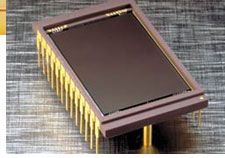 |
CCD:
KAF-6303E/LE Total Pixels: 6.3 million Array: 3072 x 2048 pixels Pixel Size: 9 microns square Antiblooming: Optional Class: 1,2 or 3 Peak QE: 68% [click to see QE chart] Image Area: 27.7 mm x 18.5 mm Focal Length at 1 arcsecond per pixel: 73 inches FOV at 1 arcsecond per pixel: 0.9 x 0.6 degrees |
Imagine a perfect mosaic of four ST-8XE images stitched together with no overlap. That is the field of view and resolution of the KAF-6303E CCD. With four times the field of view and four times the number of pixels, the 6.3 megapixel Research 6303XE is essentially like having four ST-8XE cameras imaging at once. The 9 micron pixels are small enough that the large field of view can be exploited with relatively modest telescopes of less than 100 inches focal length. High QE, blue sensitive, full frame, high dynamic range, low noise, and optional anti-blooming protection make this one of the most sought after detectors for professional use.
The Research STL-4020M
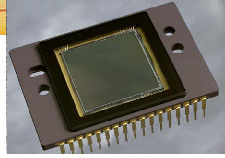 |
CCD: KAI-4020M Total Pixels: 4.2 million Array: 2048 x 2048 pixels Pixel Size: 7.4 microns square Antiblooming: Yes Class: One class with no column defects Peak QE: 55% [click to see QE chart] Image Area: 15.2 x 15.2 mm FOV at 1 arcsec / pixel: 0.6 x 0.6 degrees Focal Length at 1 arcsec / pixel: 60 inches |
Designed around the KAI-4020M progressive scan interline CCD, this is the big brother to the popular ST-2000XM. With 4 million pixels and twice the imaging area of the ST-2000XM, this camera packs a lot of punch for the price and is our entry level large format camera. The small pixel size and superb anti-blooming characteristics of Kodak's interline parts make this an ideal choice for wide field imaging through short fast refractors. The QE is very high in the blue and green compared to other interline parts from other manufacturers. Compared to Kodak's full frame sensors this CCD is less sensitive in the red and slightly higher in the blue/green.
The Research STL-4020CM
 |
CCD:
KAI-4020CM (Color) Total Pixels: 4.2 million Array: 2048 x 2048 pixels Pixel Size: 7.4 microns square Antiblooming: Yes Class: One class with no column defects Peak QE: 55% [click to see QE chart] Image Area: 15.2 x 15.2 mm FOV at 1 arcsec / pixel: 0.6 x 0.6 degrees Focal Length at 1 arcsec / pixel: 60 inches |
Update: January 30, 2004: Based on the results we have seen with the KAI-2001CM color CCD, we are considering the option of a color version of the STL-4020 camera, designated the STL-4020CM. We have not yet tested this CCD but we have a sample coming. This CCD has virtually the same specs as the KAI-2001CM on paper except for the greater number of pixels so we expect performance to be the same. If the tests show good results we will announce the availability of this model. Check with us before ordering. Price will be the same as the monochrome STL-4020M.
The Research STL-1301E
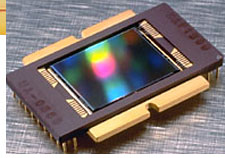 |
CCD:
KAF-1301E/LE Total Pixels: 1.3 million Array: 1280 x 1024 pixels Pixel Size: 16 microns square Antiblooming: Optional Class: One class with no column defects Peak QE: 73% [click to see QE chart] Image Area: 20.5 mm x 16.4 mm Focal Length at 1 arcsecond per pixel: 130 inches FOV at 1 arcsecond per pixel: 0.4 x 0.3 degrees |
This model utilizes a 1.3 megapixel Full Frame, Enhanced (Blue Plus) CCD with medium sized (16 micron) pixels. Like the rest of the Full Frame "E" sensors the KAF-1302E has very high QE across the visible spectrum and into the near IR. The excellent QE plus the medium sized pixels will make this camera a top performer on medium to large telescopes of greater than about 100 inches focal length. This detector is also available in an antiblooming version.
The Research STL-1001E
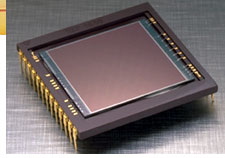 |
CCD: KAF-1001E Total Pixels: 1.0 million Array: 1024 x 1024 pixels Pixel Size: 24 microns Antiblooming: No Class: 1,2,3 Peak QE: 72% [click to see QE chart] Image Area: 24.6 mm x 24.6 mm Focal Length at 1 arcsecond per pixel: 195 inches FOV at 1 arcsecond per pixel: 0.3 x 0.3 degrees |
This CCD started our development of the large format Research line of cameras. The same CCD is used in our current SBIG ST-1001E camera. However, there were some limitations on the earlier model which have been eliminated with this design. The previous model did not have a self-guiding CCD or matching 2" filter wheel due to physical constraints in the smaller ST camera body. Also, the predecessor model used the slower parallel interface. These things are now resolved with the larger Research Model camera body, 2" internal filter carousel and high speed USB electronics.
To learn more about these systems download the SBIG Operating Manual for Research Camera Models: STL-1001E, STL-1301E, STL-4020M, STL-6303E and STL-11000M. This is a .pdf version of the complete 84 page illustrated document.
ORDERING AND AVAILABILITY - Updated March 2004
Production and deliveries of the STL-11000M and STL-1001E began in February 2004, and we are accepting orders for all models. Please contact Company Seven for further details or to place an order.
Go to Price List
Return to SBIG Products page
Contents Copyright 1994-2004 Company Seven - All Rights Reserved

